| Columns Retired Columns & Blogs |
An excellent review and article- RD.
I have enjoyed the Sophia and Sasha models. The Sabrina is next on my short-list.
I used DRA Labs' MLSSA system and a calibrated DPA 4006 microphone to measure the Wilson Sabrina's frequency response in the farfield; for the nearfield frequency responses, I used an Earthworks QTC-40, which has a ¼" capsule and thus presents no significant obstacle to the sound. For logistical reasons, I measured a different sample (serial no.0485) from those auditioned by Robert Deutsch (0375 and 0376). For the measurements, I hoisted this surprisingly heavy speaker onto my Outline speaker turntable—oh, my achin' back—and to avoid the possibility of damaging the cabinet's finish, I did not remove its protective film. As RD found the Sabrina's sound to be "just a bit less open" with the grilles, and so did all of his critical listening with the grilles removed, I performed almost all of the measurements without the grille.
My estimate of the Sabrina's voltage sensitivity on the tweeter axis was 88.2dB/2.83V/m, slightly higher than the specified 87dB. Wilson specifies the Sabrina's electrical impedance as 4 ohms, with a minimum magnitude of 2.53 ohms at 139Hz. My measurement of the impedance is shown in fig.1: the value (solid trace) varies between 4 and 6 ohms between 250Hz and 4kHz, and the minimum magnitude is 2.44 ohms at 135Hz. However, there is also a combination of 4.44 ohms and a capacitive phase angle of –58° at 72Hz, a frequency where music can have considerable energy; this will place a significant demand for current on the partnering amplifier.
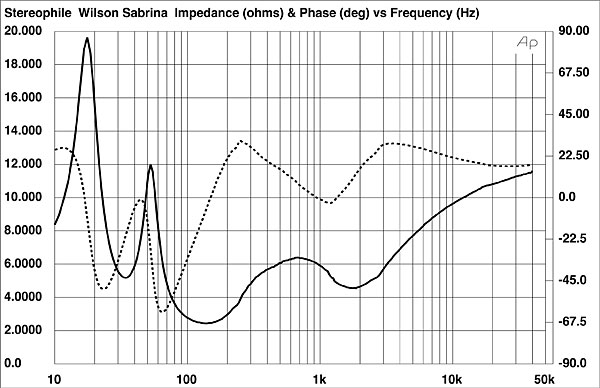
A very slight discontinuity at 240Hz in the magnitude trace (solid trace) coincides with a point of inflection in the electrical phase angle (dashed). This suggests some sort of resonant behavior in the enclosure at this frequency, though I note that RD found the Sabrina's cabinet to be extremely inert. The top part was indeed inert, but the knuckle-rap test indicated that the lower portion was slightly lively. Investigating this behavior with a plastic-tape accelerometer, I found a high-Q mode at 242Hz on the rear and side panels (fig.2), though this was relatively low in level.
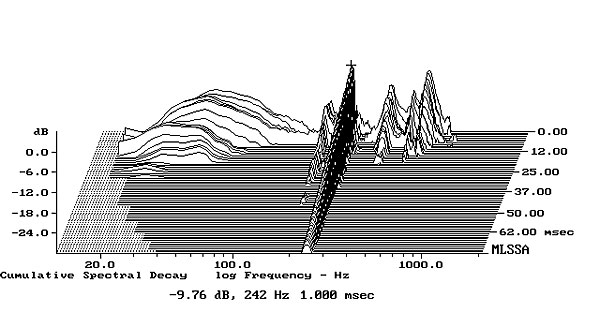
The saddle centered between 30 and 40Hz in the impedance-magnitude trace suggests that the 3"-diameter port at the base of the rear panel is tuned in this region. However, looking at the woofer's output in the nearfield (fig.3, blue trace), this has the expected minimum-motion notch—where the back pressure from the port resonance holds the woofer cone stationary—higher in frequency, at 44Hz. The port's output, again measured in the nearfield (red trace), peaks between 40 and 70Hz, and there is a small peak in its upper-frequency output at 242Hz, the frequency of the mode I found on the rear panel, followed by a steep rolloff. There is also a sharply defined discontinuity in the woofer output at the same frequency, as well as in the sum of the midrange, woofer, and port outputs (black trace). (I didn't include the contribution of the port that loads the midrange unit.)
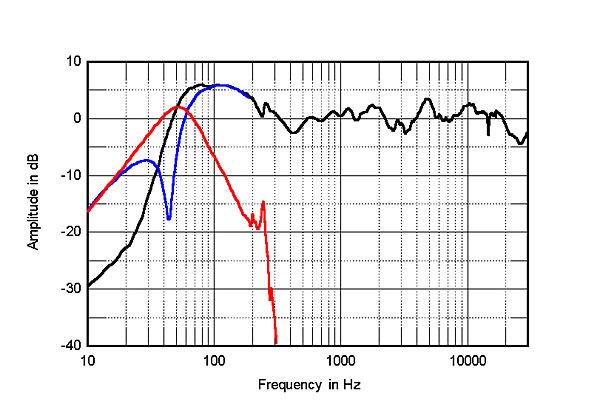
I suspect that the Sabrina has a relatively strong internal acoustic resonance at 242Hz. This resonance is of high Q (Quality factor), which means that it needs to be excited by continuous energy at that exact frequency to become fully developed. The frequency 242Hz also falls between the notes B-flat3 and B3 in Western music (when A4=440Hz)—so other than with drums, the resonance might well not be excited with music. I note that RD didn't comment on any lack of clarity in the Wilson's upper bass that could be due to this behavior—quite the opposite, in fact, as he wrote that recordings of bass drums or timpani "had appropriately quick onset and very little overhang."
The broad peak between 40 and 240Hz in fig.3 will be due in part to the nearfield measurement technique. But it does suggest that the Sabrina's woofer alignment is a little on the underdamped side, which will endow the speaker with subjectively powerful low frequencies, as RD found. Higher in frequency in this graph, the Sabrina's farfield output, averaged across a 30° horizontal window centered on the tweeter axis, is relatively even, with small dips at some frequencies balanced by small peaks at others. The most obvious feature is the slight excess of energy between 4 and 6kHz. This graph was taken without the speaker's grille. Repeating the measurement with the grille in place actually gave a more even output in the mid-treble, with the peak eliminated—although, as noted earlier, RD preferred the sound without the grilles.
There is a very narrow suckout in the tweeter's output. I initially thought this was due to the usual leakage at 15,625Hz from the measurement computer's video display, but the suckout occurs slightly lower in frequency, at 14,650Hz. This suckout was not affected by the grille, but as it is both very narrow and high in frequency, I can confidently predict that it will not be audible.
Fig.4 shows the Sabrina's horizontal dispersion, normalized to the response on the tweeter axis. The apparent flare off axis at the cursor position in this graph actually coincides with the slight lack of energy in the on-axis response, meaning that, in typical rooms, the speaker's presence-region balance will sound neutral. With the Sabrina's narrow baffle surrounding the tweeter, the speaker's top-octave dispersion is wider than is usual with a 1" dome, which is presumably why the Wilson design team didn't feel the need to boost the tweeter's on-axis output in this region. In the vertical plane (fig.5), there is very little change in the speaker's response over a ±5° window centered on the tweeter axis.
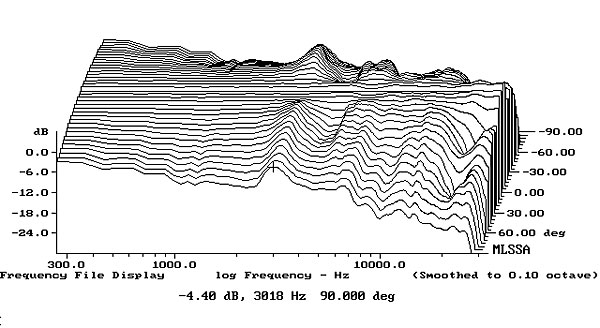
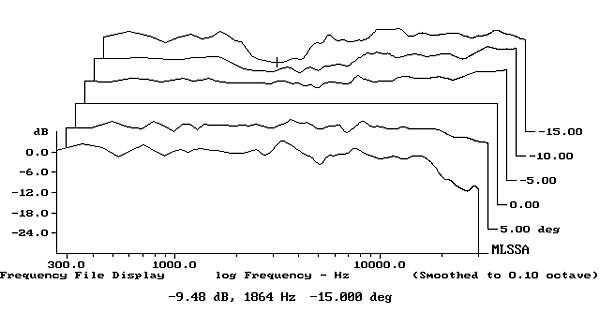
Turning to the time domain, the Sabrina's step response on the tweeter axis (fig.6) resembles that of the other Wilson speakers we've reviewed in recent years, with the tweeter and woofer connected in positive acoustic polarity and the midrange unit in negative polarity (footnote 1). But more important than the polarities is the fact that the decay of each unit's step smoothly blends with that of the next lower in frequency, suggesting that, in combination with the sloped-back baffle, the crossover has been optimally designed. The Sabrina's cumulative spectral-decay plot (fig.7) shows a clean initial decay, particularly in the region covered by the tweeter, but with some low-level modes developing in the low treble.

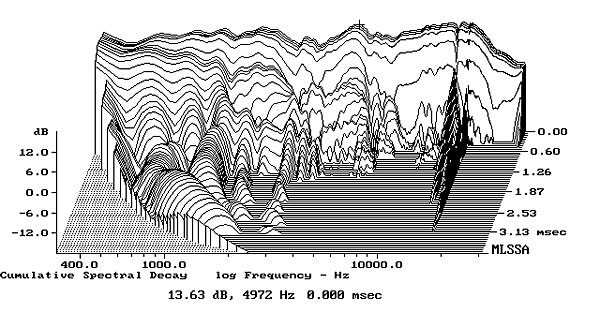
Overall, its measured behavior suggests that Wilson Audio's design of the Sabrina has been carefully optimized.—John Atkinson

An excellent review and article- RD.
I have enjoyed the Sophia and Sasha models. The Sabrina is next on my short-list.

Its almost unusual for an audio magazine reviewer to take a picture of his room and include it in his review; In this very rare occasion Robert did, excellent! reader of an article always has to simulate in his/her mind how the reviewer has setup the equipments or if he has a very especial room with lots of room treatment objects around or not, but putting a picture, can give people immediate view of how the equipments under review, has been placed and listened to. Plus, lots of hints for how he has been set up, say, a speaker in his room. And that, even a listening room belongs to a Stereophile Magazine reviewer, can be so cosy, comfortable and ordinary-looking home-made room instead of drastic professionally acoustically treated room with negative WEF( wife expectancy factor)! Thanks for review but more thanks for your room picture; Its a nice one by the way! I hope we see more pictures of whats going on during setup and listening in this magazine( not private ones of course!)

Thanks! There is more information about my listening room at http://www.stereophile.com/content/focal-aria-936-loudspeaker-confounding-cables-and-room-acoustics#lfe0BxbthAtMUTdg.97

Let me first admit I have not heard this epeaker. But I have heard the even more expensive Wilson speakers, the Sophia and Sasha and I am completely unimpressed with them, particularly given their quite high prices. They have a somewhat elevated bass. At their price point this isn't forgivable. And I don't hear the level of resolution and detail I would expect given their price.
Now here is the Sabrina at $17,000 (or $18,000 if you have them painted white or red -- must be very expensive paint!!).
I would say the Revel Performa3 F208 has got to be a much better choice for someone considering the Sabrina. It is a large three way speaker like the Wilson. But it must sound better, as it sounds better than the Sophia and Sasha!!
It has similar efficiency but unlike with the Sabrina you can adjust its low and high frequencies for room conditions. It also is at ease playing loudly. And at $5,000, I believe, it costs less than a third as much!!
In this light I cannot see why the Sabrina should have been given such a positive review.
Robert

Why not???
For example, you recently reviewed the Golden Ear Triton 1. How might this speaker "compare" to what you heard from the Wilson Sabrina?? IMO it's a natural question to ask and also the "elephant in the room." So, let's have it. Inquiring minds ....
Sure Wilson is kind of a "sacred cow" in some respects, no doubt, but that's exactly why your readership needs this type of info. Stereophile's credibility is in the balance.

It's a natural question, but comparing a speaker being reviewed with previously-reviewed speakers is problematic, unless all of these speakers are on hand for direct comparisons. The GoldenEar Triton Ones--and various other speakers I've reviewed that are potential candidates for comparisons--are long gone, and it's simply not practical to try to get them back. So any such comparison involves the memory of what those speakers sounded like--not a very good basis for evaluation. Add the fact that some of the system components have changed from earlier reviews, and you have a situation that involves potental confounding.
Having said that, on Page 3 of the review I make two references to comparisons between the Sabrinas and the Triton Ones (paragraphs 4 and 5), and paragraph 7 makes reference to the Fujitsu Ten Eclipse.

Thanks for sharing your speaker set up picture in your listening room. It looks like you have dealt well with a room much like my own. What is that material hanging on the wall behind your chair? I, too, am constrained to have wall right behind me. Please advise.
Amendment: I followed your link. I found the information for Vicoustic. Thanks for sharing what I am sure is a successful set up with speakers along what seems to be the long-wall in front.

Hi Guys,
Very nice review. I noticed something and went back and briefly checked. I was wondering where the close-mic tweeter measurements for the Sabrina were. It seems based on very few samples, that Stereophile is not publishing close-mic data for the tweeter and mids for Wilson speakers that are normally published for other makers. For instance the original Vandersteen model seven review.
I'm just wondering if there's a technical or other issue that makes you choose when to include these measurements. It's OK with me if there's even an agreement with the vendor not to share some data, but if so I would expect it to be part of the measurement data. "We've agreed with Wilson not to share close-mic tweeter data..." or something like that. Maybe it was in a previous review or I needed to read the review more closely.
Thanks for the clarifications,
Erik

Very nice review.
Thank you.
I was wondering where the close-mic tweeter measurements for the Sabrina were. It seems based on very few samples, that Stereophile is not publishing close-mic data for the tweeter and mids for Wilson speakers that are normally published for other makers.
You have me puzzled, as I don't measure tweeters with the microphone close for any review. The only measurement I didn't perform for the Sabrina review was the spatially averaged in-room response, which was not logistically possible.
John Atkinson
Editor, Stereophile

Sorry, then I'm clearly using the wrong terminology.
Looking at the original review for the Vandersteen model Seven for instance (Stereophile March 2010, Measurements Figure 4) there are "nearfield" responses for each driver but the closest Sabrina measurement (Figure 3) only includes such detail in the lower bass. Maybe I've been reading too long and didn't notice when the practice changed of when choices are made to measure them or not.
Best,
Erik

Looking at the original review for the Vandersteen model Seven for instance (Stereophile March 2010, Measurements Figure 4) there are "nearfield" responses for each driver but the closest Sabrina measurement (Figure 3) only includes such detail in the lower bass.
The nearfield measurements are only used for lower-frequency drive-units, always for woofers and ports and sometimes for midrange units when their output extends sufficiently low in frequency. But never for tweeters.
Note that the summed nearfield low-frequency response in fig.3 (black trace) does include the contribution of the Sabrina's midrange unit.
John Atkinson
Editor, Stereophile

After admiring Wilson Audio since 1982 but never having the financial resources to even consider a purchase, my wife and I are traveling to Maryland to listen to the Sabrina's.
After being mostly a Home Theater enthusiast for the last 20 years only recently have I gravitated back to the world of analog stereo. This should be interesting!